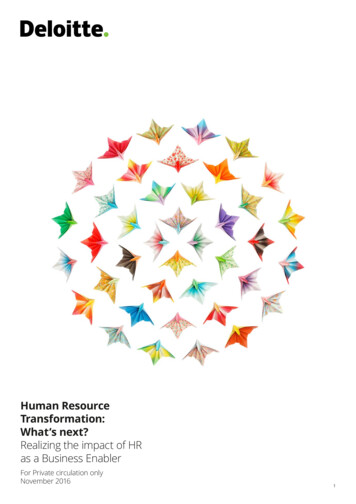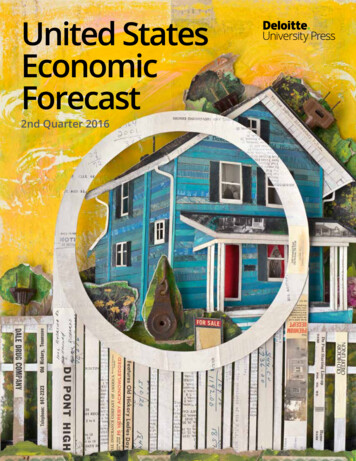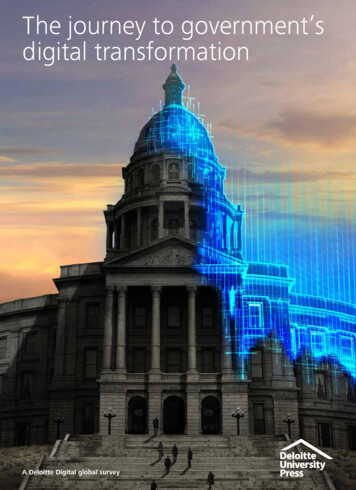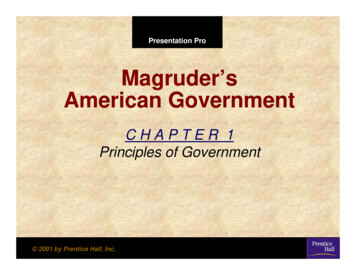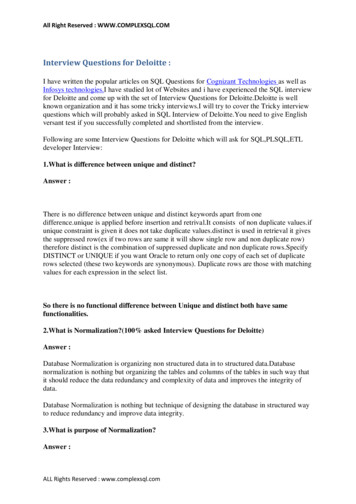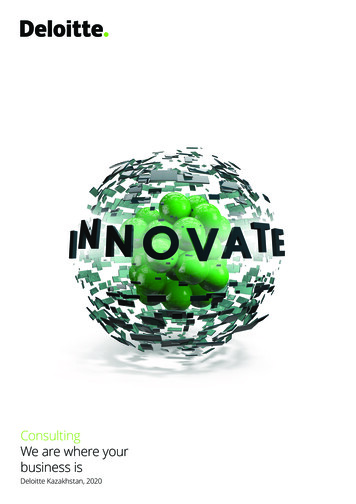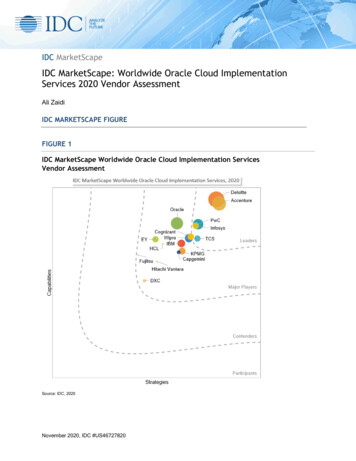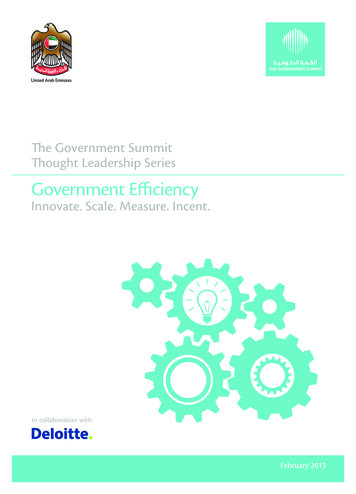
Transcription
The Government SummitThought Leadership SeriesGovernment EfficiencyInnovate. Scale. Measure. Incent.In collaboration with
02 The Government Summit Thought Leadership Series
Executive SummaryEfficiency is an increasingly core component of government reform. However, reviews of governmentproduction costs and productivity in OECD countriesindicate that governments may be getting less efficient over time. Governments are actively addressingthe topic of efficiency through the introduction ofnew practices in various areas of public service. Ourresearch shows that opportunities for improvementexist to create meaningful and sustainable efficiencygains.In order to continue to improve efficiency in the public sector, governments should focus on four key areas: pursuing innovative practices linked to efficiency;scaling the use of efficient practices; improving theuse of established measurement and analytical toolsto generate actionable insights; and strengtheningmanagement incentives to become more efficient.The Government Summit Thought Leadership Series 03
ContentsIntroduction0607081304 The Government Summit Thought Leadership SeriesMethodologyContextUAE Government Efficiency in International PerspectiveThe Public Sector’s Commitment and Experience with Efficiency ProgramsThe State of Government EfficiencyThe Characteristics of InefficiencyFour Key Driversof Government EfficiencyInnovateScaleMeasureIncent
2829Conclusion:Achieving SystematicGovernment EfficiencyReferencesAnnex33The Government Summit Thought Leadership Series 05
IntroductionEfficiency is about doing more for less. It involves maximizingoutputs such as the volume of services provided, minimizinginputs such as the amount of resources or capital required toproduce those services and maintaining or improving quality.Efficiency can be measured by how much it costs to deliver aprogram compared to previous years or compared to peers, orthe relative outcomes that governments obtain from a certainlevel of expenditure. Rising citizen expectations, ageing populations and global economic volatility have put pressure on governments to increase the value for money of public services.Against this backdrop, the UAE public service is tasked withdelivering policy and programs to meet the Government’s ambitious Vision 2021 agenda to improve healthcare and education,strengthen social programs, grow the economy, enhance publicsafety, promote environmental sustainability and improve itsglobal standing. According to the IMF World Economic Outlook, government expenditures are projected to hold steadyat approximately 22 percent of GDP. As such, the governmentneeds to ensure that existing programs are efficient and effective.and future investments represent good value for moneyThis study is an independent review of government efficiency.Although the focus is on efficiency in the Government of theUAE, the content is developed for the High Level GovernmentForum bringing together senior government officials fromaround the world. Unless otherwise stated, when the study refers to “government” it is referring to governments around the.world rather than any specific government entity06 The Government Summit Thought Leadership SeriesThis paper is divided into several sections: Section two describes the methodology which involved aseries of interviews with senior UAE Government officials,analysis of data on public sector expenditure and performance, meetings with subject matter experts in Deloitte’sGlobal Public Sector practice and reviews of leading initiatives in several countries. Section three describes the UAE Government’s efficiency ininternational perspective. It highlights that the UAE Government spends less than many other high income countries,but doesn’t get a high score on an international assessmentof government effectiveness. It reviews the increasing importance of “efficiency” in public sector organizations andlooks at governments’ track record on efficiency using available international evidence and concludes that efficiency isdeclining over time. It also describes the characteristics ofgovernment inefficiency. Section four identifies the key drivers of government efficiency and develops a framework for improving governmentefficiency. The final section concludes with a summary.
MethodologyDeveloping robust evidence on what drives efficiency is challenging because of the absence of readily comparable data ongovernment inputs, outputs and quality. Drawing the links between specific initiatives and overall efficiency is confoundedby time lags and other factors that influence efficiency but areoutside of government’s control. As such, this study has pursued a pragmatic approach. We have undertaken a brief reviewof leading practices in Australia, Canada, Singapore, and theUnited Kingdom. These countries were selected based on theirreputations as leaders in public sector management policy andpractice. The review involved selecting a set of key areas of government activity which provide significant potential for efficiency gains and developing a set of assessment frameworks to guidethe investigation. The study is informed by a variety of sources: Interviews with senior government officials in the UAE andhigh level reviews of UAE Government programs to improveefficiency Interviews with Deloitte public sector subject matter experts Selected literature and publicly available information onpublic sector reforms designed to improve efficiency Publicly available data on government spending and effectivenessPopulation(millions)Country Lessons learned from recent Deloitte experience with government efficiency improvement projectsThe comparator countries vary in size, system of governmentand level of spending. This diversity helped to clarify the com.mon trends in best practices used to generate efficiency gainsSystem of GovernmentGovernment expenditure(% of GDP)United Arab .5Federal43Singapore5.2Unitary18United Kingdom62.6Unitary46Source: IMF World Economic Outlook (data shown here is for 2011)The Government Summit Thought Leadership Series 07
ContextUAE Government Efficiencyin International PerspectiveThis is likely to reflect in part the low levels of spending in theUAE, with government expenditure at 22 percent of GDP compared to the OECD average of 44 percent of GDP.1The UAE is viewed by business leaders as one of the most efficientgovernments in the world. According to a recent internationalsurvey by the World Economic Forum that asked business leaders to rank the efficiency of the composition of public spending,UAE business leaders were more likely to rank their governmentas efficient than business leaders in any other country exceptSingapore. Over the previous five years, business leaders in theUAE have been consistently more positive about the efficiencyof public spending than those in the OECD (see figure 1 below).However, the UAE is ranked 48th in the world in global comparisons of government effectiveness. Taking into account bothspending and effectiveness2, the UAE performs at a level that iswell within the “efficiency frontier” set by leading countries suchas Finland and Singapore. Like all governments, the priority is toensure that any additional investment made by government hasa high degree of value for money.Figure 1Perceptions of government efficiencyHow would you rate the composition of public spending in your country?1 highly wasteful 7 highly efficient765432120082009UAE20102011OECD CountriesSource: World Economic Forum Executive Opinion SurveyApproximately 100 business leaders were surveyed in each country and asked to rate the composition of public spending.The OECD Average is reported here.08 The Government Summit Thought Leadership Series2012
Figure 2Government expenditure as % of GDP504540OECD Average:44% of GDP35UAE: 22% of GDP% of GFD302520151050OECD Government SpendingUAE Government Spending2002 2003 2004 2005 2006 2007 2008 2009 2010 2011Source: International Monetary Fund World Economic OutlookFigure 32011 Government spending as % of GDP and Government Effectiveness2.502.001) Highly effective,but paying for itFinlandDenmarkSwedenCanadaUK1.502) Highly effectiveand efficientSingaporeNew ction oftravelHong KongQatarKoreaTaiwanUnited Arab Emirates3) Efficient but less effective0.500.00504030-0.5020100Govt Expenditure (% of GDP)-1.00-1.50KEYComparator countries-2.00Source: World Bank Worldwide Governance Indicators and IMF World Economic Outlook DatabaseIn its Worldwide Governance Indicators (WGI), the World Bankhas been evaluating six dimensions of governance for 215 countries since 1996. It is composed of six sub-indicators: voice andaccountability, political stability, government effectiveness,regulatory quality, rule of law and control of corruption. Thesegovernance indicators provide a quantitative measure of governance performance to assist in policy reform and monitoring. Government effectiveness, one of the six sub-indicators,“captures the perception of the quality of public services, thequality of the civil service and the degree of its independencefrom political pressures, the quality of policy formulation andimplementation, and the credibility of the government’s commitment to such policies”. 3The main focus of this indicator isto report on the “inputs” required for governments to achievepolicy and program objectives. The WGI combines the perceptions of enterprise, citizen, and expert survey respondents indeveloped and developing countries. The data is gathered from30 individual data sources including the World Economic Forum Global Competitiveness Report, Transparency InternationalGlobal Corruption Barometer Survey, the World Bank CountryPolicy and Institutional Assessments, Bertelsmann Transformation Index, Reporters without Borders, and the Economist Intelligence Unit Risk-wire and Democracy Index.4 An “effectiveness”score is given to each government between -2.5 (weak) to 2.5(strong) to assess government performance.The Government Summit Thought Leadership Series 09
The Public Sector’s Commitment andExperience with Efficiency ProgramsGovernments around the world are continually searching forways to deliver services that reduce cost and improve quality.Public expenditure is subject to scrutiny from audit bodies,central agencies, expenditure review programs, political decision makers, media, think tanks, academia, and even “arm-chairauditors” through transparency initiatives. Some governmentshave set up efficiency and reform units to drive efficiency savings from the center of government while others have undertaken large scale spending review programs. It is thereforeunsurprising that efficiency is increasingly identified as a corepublic service value alongside more traditional values such asimpartiality and legality (see figure 4 below).In a recent study, the International Monetary Fund has identified71 cases of consolidation programs in the last 30 years aimedat reducing budgets by more than 5 percent of GDP.5 Thesecases include both high income and emerging economies andcover a variety of different political systems. The message fromthese episodes is that large scale fiscal consolidations are painful. Public servants who have looked back on these processeshave explained that they are extremely challenging and point tothe difficulty of innovating while under extreme cost pressure.As such, it is considered good practice for governments to beproactive and improve the efficiency of operations during lessconstrained times.Figure 4Frequently stated core public service values (OECD) (2000 and 2009)% 10%20%30%40%50%60%70%80%90%% of countries indicating a core valueSource: OECD Government at a Glance, 200910 The Government Summit Thought Leadership Series100%20092000
The State of Government Efficiencycates that despite nearly halving the size of the UK civil service,costs have remained stable over a forty year period.8 In the US,forthcoming analysis by Deloitte indicates while private-sectorproductivity grew by 60 percent during a 47 year period, productivity in the public sector dropped by more than 10 percent.9Although the UAE has not undertaken a large scale review ofgovernment efficiency, the trend in other jurisdictions providesa cautionary tale: as governments innovate and reform, government budgets have been increasing and sometimes withoutcommensurate improvements in outcomes.Despite all of the emphasis on efficiency, existing assessmentsof government activity indicate that production costs are risingand efficiency has been declining over time. According to theOECD between 2000 and 2009, production costs in governmentrose from 20.9 percent of GDP to 23.3 percent of GDP 6 (seefigure 5 below). In the UK, a review by the national statisticsagency estimates that public sector productivity has fallen by anaverage annual rate of 0.3 percent.7 A more recent analysis indi-Figure 5Government production costs as a percentage of GDP 2000 and 2009(% change in ed Kingdom(31.6%)Canada(17.5%)Norway(12.4%)New )Ireland20092000(44.8%)United (1.8%)05101520253035% of GDPSource: OECD Government at a Glance 2011, selected countries displayed hereProduction costs include compensation costs of general government employees, costs of goods and services produced by nongovernment entities paidfor by government and consumption of fixed capital.The Government Summit Thought Leadership Series 11
The Characteristics of InefficiencyRecent efficiency reviews in Australia10 , Canada11 and the UK12point to significant opportunities for efficiency gains in government. One example is the wide variation in prices for commongoods and services purchased by the UK Government. The UK’sGreen Review found that a box of paper ranged from a high of 73 to a low of 8 while printer cartridges ranged in price from 398 to 86.13 Higher than necessary costs had been incurredas a result of a failure to obtain a more standardized approachto purchasing and contracting. An absence of an integratedapproach to both front office and back office services also creates costly overlap and duplication across government. Multiplepoints of entry and overlapping services lead to administrativeredundancies and critical information not being shared betweenagencies. Managers have overlapping responsibilities Personnel are engaging in unnecessary or inefficient planning activities Fragmented delivery models exist causing redundancy acrossdepartments Inefficient and overly complex business processes that donot add value Overly complex business applications and IT infrastructure Activities delivered in-house that would be less costly and /or more effective if outsourced Redundant facilities/offices (across geographies and departments) Manual processes that could be automatedRecent efficiency advisory experience suggests a number of inefficient practices commonplace in government: Senior managers are sometimes responsible for tasks thatcould be handled by more junior personnelManagers have narrow spans of control or 1:1 reportingrelationshipsThere are a large number of reporting layers12 The Government Summit Thought Leadership SeriesA more comprehensive list of inefficient practices is listed inAnnex.While this state of affairs can not only crowd out efficient practices, it can also undermine the efficacy of the public service.The next section presents a four step model for systematicallyimproving the efficiency of government.
Four Key Drivers ofGovernment EfficiencyEfficiency reviews are not just about cost reduction. They alsorepresent an opportunity to examine programs and services toensure they meet government objectives, become more effective and deliver higher quality service. In some cases like theUAE Unique Identity Authority, investment is required to deliver efficiency savings over time. In other cases, cost reductionprograms that involve adjustments of mandate and scope candeliver rapid efficiency gains. For example, some governmentshave reduced the breadth and depth of coverage for social entitlement programs. Efficiency can go hand in hand with greatercitizen satisfaction while at other times there is a tradeoff between cost and quality. With different paths to efficiency, thereare four key drivers to systematic efficiency in government: Innovate: There needs to be a constant process of innovation. Leading practices need to be identified, adapted andimplemented. Scale: There needs to be an ability to mandate or provideclear direction for scaling up innovations. Without a governance structure that is responsive to innovative and leadingpractices, good ideas fail to make an impact. Measure: There needs to be a clear focus on measurementand analysis. Without an analytical capability, inefficientpractices tend to persist and efficient practices are less likelyto be scaled appropriately. Incent: Governments need tighter sanctions and clearer incentives to drive efficiency at the highest levels.This model can be applied both to programs introduced as wellas to the government as a whole. For example, stronger incentives should apply to specific initiatives as well as to leaders responsible for ensuring value for money in government.The Government Summit Thought Leadership Series 13
InnovateIn order to improve efficiency in government a process of innovation is critical. As productivity does not rise at the same ratein all areas of the public sector it is important to recognize thatthe characteristics of different functions means that each willbe different in terms of extracting efficiency gains. For example,functions that can be automated and outsourced may be morelikely to generate efficiency gains than those that are necessarilylabor intensive. Innovation is enabled by a combination of technology, process and operations as well as a better evidence baseand effective process of risk management. Yet, there are different categories of innovation. Incremental innovation involvesimplementing changes to existing practices and includes theadoption of leading practices in government. Innovation can beof the “disruptive” variety when it provides a way to make publicprograms radically cheaper without slashing services. While thistype of innovation has historically been less commonplace ingovernment it should be introduced to form part of an overallinnovation program.To drive and sustain innovation, a culture of measured risk-taking is critical. One interviewee likened the role of a governmentofficial to a business person constantly seeking to increase (public) value. In the same way that the private sector focuses onthe bottom line, more entrepreneurialism is required to drivegovernment forward. The interviewee pointed to the role thatResearch and Development plays in a private sector organization and argued that more sustained research and analysis ingovernment could help to build better government services.We have reviewed dozens of leading practices that governmentsare pursuing in the UAE, Australia, Canada, the UK and Singapore. We list several of the most promising innovations thataddress key issues in government efficiency such as fragmentation of delivery, overlapping responsibilities, and duplicationand multiple points of entry for citizen services. The paper alsodescribes the more radical approach of disruptive innovation tobreak the tradeoff between performance and cost.Citizen Service DeliveryMany governments around the world are actively assessing theircapabilities for delivery of citizen and business services acrosschannels and many have launched major service transformationefforts. Citizens are increasingly looking for simple, timely, secure, and self-service ways to interact with government acrossinternet, phone and in-person channels. Governments are striving to lower the costs of service delivery and seeking better waysto interact with citizens and businesses. To address these trends,government service delivery organizations around the world are14 The Government Summit Thought Leadership Seriesaiming to become more efficient while improving service effectiveness.Examples of recent public sector initiatives include: Proactively migrating service interactions with both citizensand businesses to single point of entry service centers, callcenters and lower cost internet channels. Taking more of an enterprise-wide approach to servicedelivery by building a new cross-department organizationwith accountability and governance for service delivery. Driving common identity management initiatives acrosslevels of government, including collaboration with privatesector leaders such as financial institutions. Taking advantage of rapidly evolving technologies (indeveloping countries in particular) to consider a directmove to internet-based service rather than building legacychannels such as in-person or call center. Working with a broad set of third parties to consider new andinnovative means of service delivery including outsourcingand various public-private partnerships. Exploring new channels of service delivery such asmobile service and social media for proactive two waycommunication.With this clear trend to “multi-channel access and service delivery,” several interviewees pointed to the role that technologycan play and in particular, automating self-service. For commonservice transactions cost estimates vary widely depending onthe channel used. Deloitte experience suggests that in a countrylike Canada, costs for in person transactions are approximately 25 per transaction, live voice phone calls are 10, automaticphone calls are 5 and web based self-service is 0.25. In otherwords, an in person transaction is regularly seen to be up to 100times more costly than a web based self-service transaction. Forhigh volume transactions such as registrations, certificates andlicenses innovation in automation can provide very significantefficiency savings.International reviews of the cost of service delivery also point tothe very significant savings that can be achieved through channel shifting. A recent Deloitte review of transaction costs reported in a local council in England, civil service department inNorthern Ireland and US state government indicate that the costof online transactions can range between two and ten percentof the cost of an in-person transaction. In a recently released
report on digital efficiency, the UK Cabinet Office found that thegovernment could save at least 1.7bn per year by shifting thetransactional services currently offered by central governmentdepartments from offline to digital channels.14 These savingswould be generated through reductions in staff, property, materials and office equipment costs. In addition, the report foundthat if half an hour were saved by digitizing every transactioncurrently completed offline the overall savings to the economycould be up to 1.8 billion.In the 2012 United Nations E-Government Index, the UAE improved its overall position from 49th in 2010 to 28th, to becomeranked first amongst Arab countries, second amongst peers inWestern Asia, and fifth in Asia.15 The UAE’s position in the eservice index moved from 99th to 7th and in the e-participation index, its position improved from 86th to 6th.16 This wasachieved by conducting an in-depth review of whole of government service delivery to provide a more detailed understanding of the factors for improvement in e-government and incorporating a strategic plan into the “UAE Vision for 2021”. Thegovernment conducted a review of best practices, introduceda program to standardize websites and improved its capabilityfor online transactions. The UN lists the UAE as one of the fewcountries in the world that comes closest to a “one-stop shop” ofgovernment information and offerings. A “platform” approach isused to provide an interface with common tools and functionalities for local service delivery actors that can be customized tomeet the needs of their clients. Additionally, the governmenthas incorporated instant messaging, audio-overlay for the hearing impaired, multi-channel service delivery, and adjusts serviceofferings and delivery methods based on citizen feedback in acitizen-centered approach to e-government services. Based onits rapid progress in developing e-government solutions, the UNnamed the UAE as a global “new leader”. Below are several leading practices in service delivery being adopted by governmentsin the UAE, Australia, Canada and Singapore.UAE Unique Identity ProgramThe UAE has implemented a number of leadingpractices designed to radically improve the efficiency of government through better servicedelivery. The UAE National Identity Program aims to improveidentification and authentication mechanisms to provide better service to citizens as well as reduce crime, eliminate identitytheft, control immigration and reduce benefit fraud. The centerpiece of the project is an integrated population register that willbecome the central reference point for the whole of governmentpopulation identification and service delivery. The demographicinformation in the register will support strategic decision making on resource allocation and long term planning. By having aclear idea of how local population needs change over time thedata will inform requirements for building schools, hospitalsand infrastructure. The rapid identity verification has enabledthe government to reduce the time it takes to verify identity incourt services from 7 minutes down to 7 seconds – a reductionof 600 percent. In high volume services, the time savings cantranslate into major efficiency gains by radically lowering laborcosts. To date, the government has enrolled 98 percent of thepopulation and projects the entire population to be enrolled bythe end of the year. As part of this process, the agency responThe Government Summit Thought Leadership Series 15
sible for this program will interact with fifteen other agenciesas well as the ministries of education, labor, justice and health.Canada’s Integrated Case ManagementAcross the OECD, social services account forroughly 1 in every 4 of government spending.17 In the Canadian province of British Columbia (BC) over 3.8 billion a year is spent on key social programssuch as employment benefits and childcare subsidies in the ministries of Children and Family Development and Social Development.18 Yet, these services are often delivered in a fragmentedway that impedes information sharing on at-risk clients and isnot organized around client needs. In addition, determining service eligibility involves complex calculations based on frequentlyevolving legislation and government policy. To resolve some ofthese challenges, the BC government is reforming the delivery ofkey social services by using innovative technology in a programknown as Integrated Case Management (ICM). The ICM systemwill replace 50 outdated, fragmented, and inflexible computersystems that deliver services in 20 programs across two ministries.19 The technology allows real time calculation of benefitsand provides greater visibility of client interactions. This initiative also has a “no-wrong-door” approach to delivery throughthe use of online self-service, call center or cross-program servicecenters to increase convenience and availability. This programwill reduce technology costs and enhance service delivery whileimproving the quality and timeliness of the customer experienceto over 200,000 social service clients each year.20Singapore’s Public Sector InfrastructureInternet is universally available in Singaporewith a connectivity rate of 99 percent of thetotal population.21 This creates a significant potential for the government to utilize online channels to increaseefficiency of service delivery via its Public Service Infrastructure(PSi) program. PSI is a complete end-to-end platform for government agencies to develop, initiate and operate e-services as apart of their online e-Government programs. PSi has been created using “build-once, reuse-always” features such as securely collecting payment, customer authentication, and data exchangeacross government departments and agencies. As PSi is a centralized program that is utilized across departments and agencies, the Singapore Government is able to leverage economiesof scale because individual ‘end-user’ departments do not needto develop their own, incompatible e-service infrastructure.Unique development, testing, quality assurance, and production environments have been developed to ensure excellence inquality and operations of this e-service delivery program.22 ThePSi initiative won the Intelligent 20 Award, the Explorer Awardat E-GOV 2002, and the CIO Award in 2001 for its innovation inefficient online government service delivery.2316 The Government Summit Thought Leadership SeriesAustralia’s EZyRegEighty-nine percent of Australians own a mobilephone, with the market dominated by internetenabled devices.24 When internet was an option,47 percent of Australians used it in their most recent contactwith the government.25 Additionally, 46 percent of Australiansstated that they prefer the internet over other forms of contactwith the government such as telephone or in person.26 To respond to this trend, Service South Australia developed EZyReg,a mobile application that provides easy access to regularly usedvehicle registration services through purpose-built mobile technology. EZyReg increases the availability of government and information services in South Australia using a delivery methodthat is preferred by citizens. This online service was
.and future investments represent good value for money This study is an independent review of government efficiency. Although the focus is on efficiency in the Government of the UAE, the content is developed for the High Level Government Forum bringing together senior government officials from around the world. Unless otherwise stated, when the .

